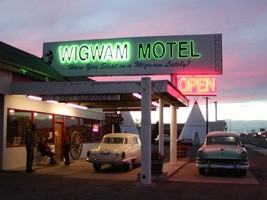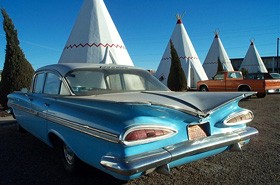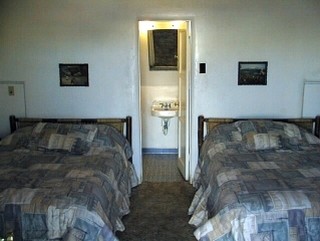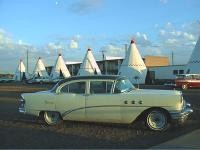Wigwam Village Motel #6
Introduction
Text-to-speech Audio
Images




Backstory and Context
Text-to-speech Audio
When Chester E. Lewis drove through Cave City, Kentucky in 1938, he discovered Frank Redford’s original Wigwam Village and was inspired to create his own such motel community in Arizona so that visitors along Route 66 could “Sleep in a Wigwam.” Lewis purchased the rights to use the Wigwam Village name and constructed the settlement in Holbrook, Arizona between 1936 and the early 1950s. It was the sixth such village, hence its name as “Wigwam Village #6.” The village was a success for about twenty years, until Interstate 40 was constructed near Holbrook in the early 1970s, and Route 66 became much less traveled. When Lewis had to sell the motel, the new owner kept the village open only as a service station for several years.
The name “Wigwam Village” is a misnomer, as a true wigwam is a rounded structure made of timber, fur, and mud; the Wigwam Village is actually modeled after the teepees of the Plains Indians. Redford disliked the name “Teepee Village” and opted instead for what he considered the more stylistically pleasing, albeit incorrect, name of “Wigwam Village.” The Village consists of fifteen large “wigwam” structures laid out in a rectangle, intended to model an American Indian village; even the two flanking wigwams next to the main office are intended to represent the chief’s dwelling place. These two wigwams serve as restrooms, one for men and one for women.
Each of the fifteen wigwams is identical in size and is spaced evenly, with a juniper tree planted between each one. They are conical, with a base of twenty-one feet and a height of twenty-eight feet, constructed in a series of equilateral triangles for support and built with wood and chicken wire. Inside, each wigwam has an eight-foot ceiling (with the remainder of the structure’s height being hollow or used for wiring and plumbing) and a partition that separates the bathroom from the bedroom; the bathroom has a shower, sink, and toilet. The exterior is painted with white latex and a red zigzag pattern along the top of the doorway, designed to resemble lightning.
In 1988, Lewis’s wife and children repurchased the village and decided to reopen the motel that had been serving only as a service station for many years. The office is a typical administrative building complete with a gift shop and a small museum that holds Lewis' Indian artifacts, his Civil War memorabilia, pieces of regional petrified wood, and other sundries. The village holds nostalgia for Baby Boomers who remember it from their childhood trips along Route 66 and is a popular destination for people traveling along Route 66. Today, only Frank Redford’s Cave City Wigwam Village and Wigwam Village #6 remain in good standing. Both are listed on the National Register of Historic Places; Village #6 was added in 2002.
Sources
Wigwam Village Motel #6. National Park Service. . . https://www.nps.gov/nr/travel/route66/wigwam_village_hotel6_holbrook.html.
History. Welcome to the Wigwam Hotel. . . www.galerie-kokopelli.com/wigwam/history.html.
